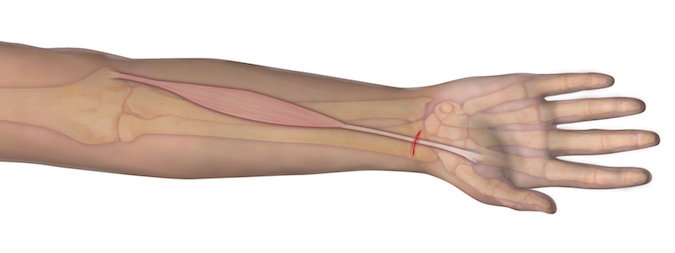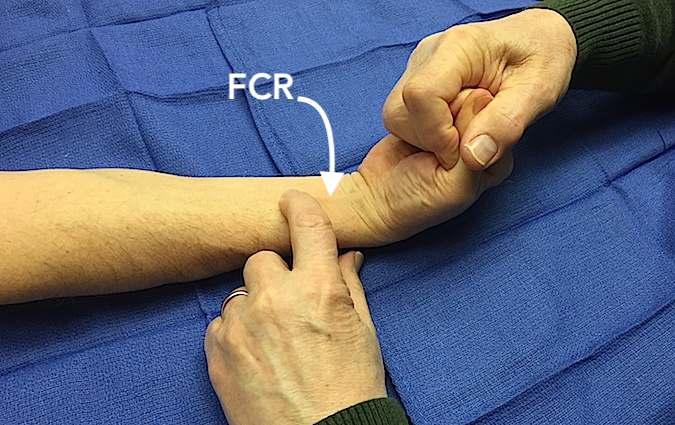Flexor Carpi Radialis
When assessing a finger injury for signs of flexor carpi radialis (FCR) laceration, the goal is to determine whether the FCR tendon is completely lacerated, partially transected, or intact.
The first step in the examination is to observe the resting posture of the wrist and forearm. When the hand is resting on the exam table with the forearm supinated, the examiner may observe a laceration in the area of the FCR tendon and/or a mild tendency for the wrist to ulnarly deviate. These observations are consistent with a possible FCR tendon laceration.
If the patient can cooperate with the request for active wrist palmar flexion, then the second step is to ask the patient to actively palmar flex the wrist joint. Observing active flexion wrist flexion without any tendency to ulnar deviate will suggest an intact FCR tendon. Ulnar deviation during wrist flexion or the inability to flex actively would be consistent with a FCR tendon laceration.
The third step is to perform muscle testing of the flexor carpi radialis (FCR) tendon if the patient can tolerate a gentle exam.
In the examination of an uninjured FCR musculotendinous unit, the 0 to 5 muscle testing grading system is applied. In this system, zero indicates a total loss of flexor carpi radialis (FCR) contraction, while a grade of 5 represents normal FCR function capable of contracting against standard resistance. Detailed information on graded muscle testing is provided below. Typically, full muscle testing is impractical in cases of acute laceration due to pain and tenderness. As noted above, the examiner may have to rely on the observation that the laceration occurred in the palmar section containing the FCR. Nevertheless, the examiner should assess the contraction of the potentially injured musculotendinous unit as comprehensively as possible. The examination's primary aim is to preoperatively determine whether the tendon is completely, partially cut, or intact. To evaluate the FCR musculotendinous unit, rest the patient's hand and upper extremity on the table with the forearm in supination and the wrist in a neutral or mildly dorsiflexed position. Instruct for the patient to “Flex your wrist. Hold it. Don’t let me straighten it.”
Definition of Positive Result in FCR Muscle Testing: A normal result is a positive one. During a normal muscle test, the examiner should observe a normal muscle contraction that can move the joint or tendon against full normal resistance.
Definition of Negative Result in FCR Muscle Testing: The FCR tendon should be observed and palpated and compared to the uninjured side. In muscle testing, an abnormal result is a negative one. During a partially abnormal muscle test, the examiner should observe an abnormal muscle contraction that can move the joint or a tendon but not against normal resistance. In a complete denervation injury, such as a high median nerve complete laceration, there may be no evidence of any muscle contraction, and the muscle testing grade will be zero.
In a patient with a laceration of the FCR in sections 9 or in the proximal volar forearm, the wrist joint may not normally palmar flex due to a complete transection (cut) of the FCR tendon possibly in association with a FCU laceration. This results in an abnormal or negative muscle testing or possibly a grade 3 due to muscle belly contraction without active wrist palmar flexion. However, this observation can indicate a complete FCR laceration requiring surgical repair. Thus, this negative muscle testing exam will be positive for a complete index FCR laceration. Likewise, loss of normal active wrist palmar flexion may also indicate a complete FCR tendon laceration.
- Tenderness of the distal FCR tendon at the distal wrist crease can be associated with FCR tendonitis; however, pressure applied to the volar distal FCR tendon can cause tenderness because an underlying distal scaphoid fracture or STT osteoarthritis.
- Volar ganglions can be associated with the distal portion of the FCR tendon.
- Corticosteroid injections can be used to manage FCR tendonitis.
- FCR tendon can be ruptured in association with STT OA, ganglions, or repeated cortisone injections.
- Half or all the FCR tendon is sometimes used for reconstructing the ulnar collateral (volar beak) ligament of the thumb CMC joint ligament for hyperlaxity or after trapezial excision for thumb CMC OA.

